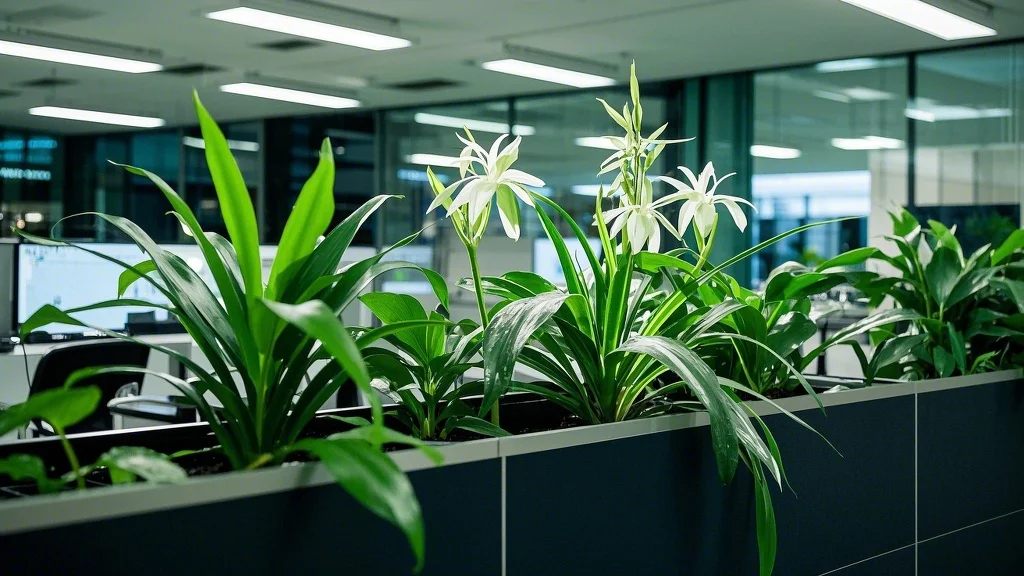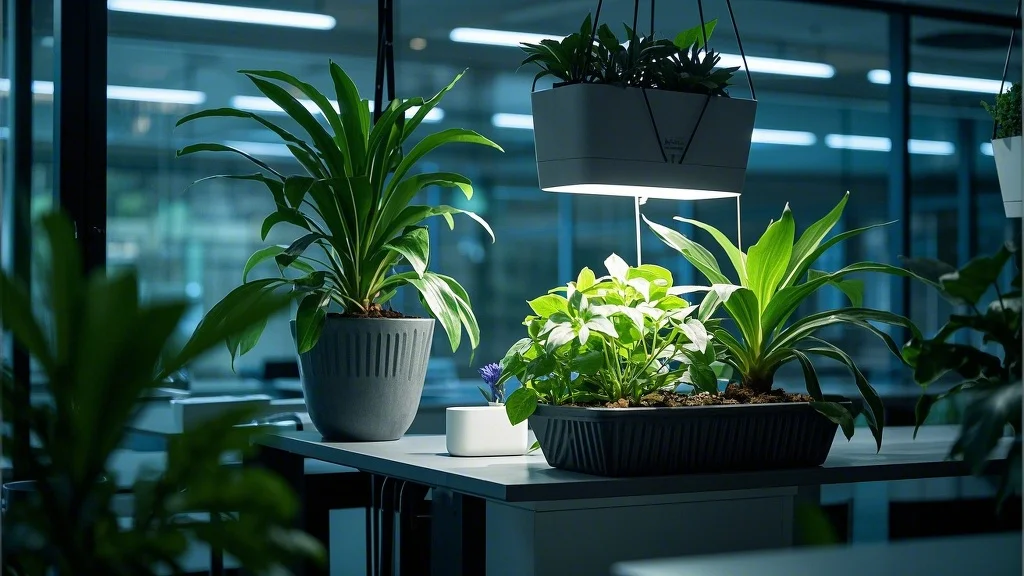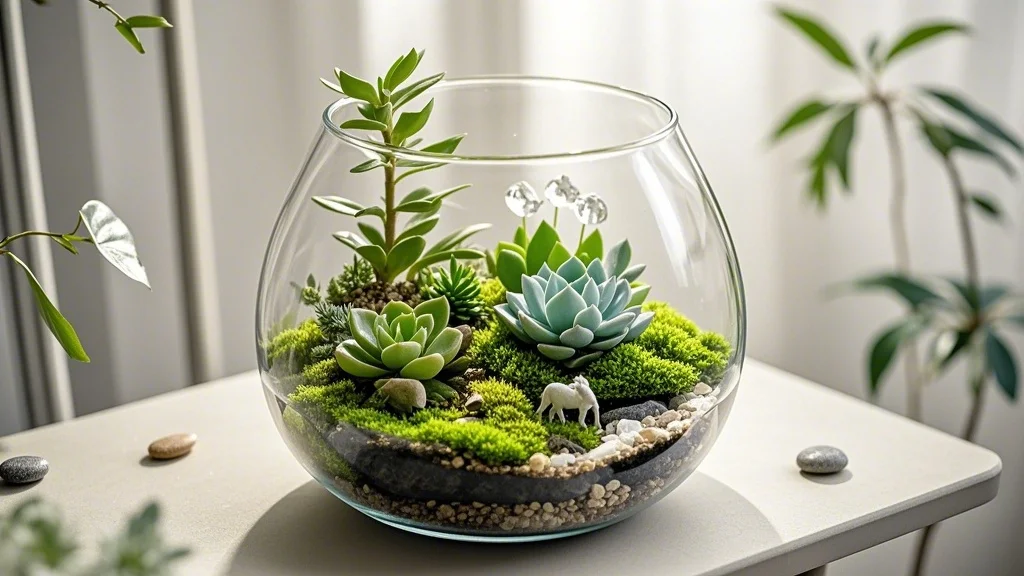Working in a windowless office doesn’t mean you have to sacrifice the benefits of having plants in your workspace. Despite the lack of natural light, numerous plant varieties can thrive under artificial lighting conditions, bringing life and vitality to even the most challenging environments. Indoor plants have been proven to boost productivity, reduce stress, improve air quality, and enhance the overall aesthetic of office spaces—benefits that are perhaps even more valuable in windowless environments.
This comprehensive guide explores the best plant options for offices without windows, providing you with practical solutions to introduce greenery into your workspace regardless of lighting limitations. We’ll cover low-maintenance options that can survive and even flourish under artificial lights, transforming your windowless office into a more vibrant and healthy environment.
Contents
- 1 Why Add Plants to a Windowless Office?
- 2 Understanding Light Conditions in Windowless Offices
- 3 Top 10 Plants for Windowless Offices
- 3.1 1. Snake Plant (Sansevieria)
- 3.2 2. ZZ Plant (Zamioculcas zamiifolia)
- 3.3 3. Pothos (Epipremnum aureum)
- 3.4 4. Chinese Evergreen (Aglaonema)
- 3.5 5. Peace Lily (Spathiphyllum)
- 3.6 6. Cast Iron Plant (Aspidistra elatior)
- 3.7 7. Philodendron
- 3.8 8. Dracaena
- 3.9 9. Spider Plant (Chlorophytum comosum)
- 3.10 10. Parlor Palm (Chamaedorea elegans)
- 4 Setting Your Office Plants Up for Success
- 5 Supplemental Lighting Options
- 6 Common Challenges and Solutions
- 7 Conclusion
Why Add Plants to a Windowless Office?
Before diving into specific plant recommendations, let’s consider the unique benefits plants bring to windowless workspaces:
- Improved Air Quality: Plants naturally filter air pollutants, which can be especially concentrated in enclosed spaces with limited ventilation.
- Psychological Benefits: Research shows that indoor plants can reduce stress and anxiety while improving mood and concentration—crucial factors in environments lacking natural light.
- Humidity Regulation: Plants release moisture through transpiration, helping to combat the dry air often found in office buildings with central heating and air conditioning.
- Visual Interest: Adding greenery to a space without windows provides visual stimulation and breaks up the monotony of blank walls and office furniture.
Understanding Light Conditions in Windowless Offices
Types of Artificial Light
Not all artificial lights are created equal when it comes to supporting plant life:
- Fluorescent Lights: Common in offices, standard fluorescent lights provide a decent spectrum for plants, especially if they’re “cool white” or “daylight” bulbs.
- LED Lights: Energy-efficient and increasingly common, LEDs can support plant growth if they provide the right spectrum.
- Incandescent Lights: These generate too much heat and not enough of the right light spectrum for most plants.
Light Duration and Intensity
For plants to thrive in a windowless environment:
- Most office plants need 12-14 hours of artificial light daily
- Position plants within 36 inches of light sources when possible
- Consider supplemental grow lights for optimal plant health
Top 10 Plants for Windowless Offices

1. Snake Plant (Sansevieria)
Light Requirements: Extremely adaptable to low light conditions
Care Level: Very easy
The snake plant tops our list for good reason. These architectural beauties with stiff, upright leaves can survive in almost any lighting condition, including the dim corners of windowless offices. They require minimal watering—only when the soil is completely dry—making them perfect for busy professionals who might forget regular plant care.
Snake plants are exceptional air purifiers, converting CO2 to oxygen even at night (unlike most plants). Their striking appearance adds a modern touch to any office décor, and they’re available in various sizes from desktop varieties to floor specimens reaching several feet tall.
2. ZZ Plant (Zamioculcas zamiifolia)
Light Requirements: Tolerates very low light
Care Level: Very easy
The ZZ plant has gained popularity as the ultimate “impossible-to-kill” office plant. Its glossy, dark green leaves maintain their luster even under artificial lighting, and its drought-tolerant nature means it can go weeks without water. The plant’s rhizomatous root system stores water, allowing it to survive neglect that would kill most other houseplants.
ZZ plants grow slowly in low light conditions, meaning they won’t quickly outgrow their space. Their clean, sophisticated appearance makes them suitable for modern office environments, from reception areas to conference rooms.
3. Pothos (Epipremnum aureum)
Light Requirements: Adaptable to low light
Care Level: Easy
Pothos plants are incredibly versatile, thriving in a range of conditions including offices with only fluorescent lighting. Their cascading vines with heart-shaped leaves can be trained up supports or allowed to trail from elevated surfaces, adding dynamic visual interest to static office environments.
Available in varieties like Golden Pothos, Marble Queen, and Neon, these plants offer different foliage patterns and colors to suit your office aesthetic. They’re also excellent air purifiers, removing common indoor pollutants like formaldehyde from the air.
4. Chinese Evergreen (Aglaonema)
Light Requirements: Thrives in low to moderate light
Care Level: Easy
Chinese Evergreens are prized for their beautiful, often variegated foliage that adds color to dim office spaces. These plants actually prefer the filtered, indirect light that mimics their natural habitat beneath forest canopies, making them perfect for artificial light conditions.
Newer varieties offer striking red, pink, or silver variegation that can brighten up a windowless space. They’re relatively slow-growing and don’t require frequent repotting, making them low-maintenance office companions.
5. Peace Lily (Spathiphyllum)
Light Requirements: Tolerates low light
Care Level: Moderate
Peace lilies stand out among low-light plants for their ability to produce elegant white blooms even under fluorescent lighting. Their glossy, deep green leaves create a lush appearance, and they’re known for their exceptional air-purifying qualities.
These plants will communicate their needs clearly—drooping leaves signal it’s time to water, making it easier to establish a care routine. While they require more consistent moisture than some others on this list, their visual impact and air-cleaning benefits make them worth the extra attention.
6. Cast Iron Plant (Aspidistra elatior)
Light Requirements: Extremely tolerant of low light
Care Level: Very easy
Living up to its name, the cast iron plant is nearly indestructible and can thrive for decades in challenging conditions. Its broad, leathery dark green leaves grow from the soil in an attractive fan pattern, providing textural contrast to other office plants.
This slow-growing plant rarely needs repotting and can tolerate irregular watering, temperature fluctuations, and the dry air common in office environments. Its resilience makes it ideal for offices where plant care might be inconsistent.
7. Philodendron
Light Requirements: Adapts well to low light
Care Level: Easy
Philodendrons come in climbing and non-climbing varieties, all of which adapt remarkably well to indoor conditions without natural light. Heartleaf philodendron (Philodendron hederaceum) is particularly well-suited to office environments, with its trailing vines of glossy, heart-shaped leaves.
These plants communicate their light needs clearly—leggy growth indicates they need more light, while burned leaves suggest they’re getting too much. Under standard office lighting, they typically maintain a balanced, attractive growth pattern with minimal care.
8. Dracaena
Light Requirements: Tolerates low to moderate light
Care Level: Easy to moderate
The Dracaena genus includes several species that perform well in offices without windows. Dracaena fragrans (Corn Plant), Dracaena marginata (Dragon Tree), and Dracaena warneckii all feature striking, architectural forms with strappy leaves that add height and visual interest to office spaces.
These plants can grow quite tall over time, making them excellent options for floor plantings in reception areas or conference rooms. Their air-purifying qualities are well-documented, removing toxins like benzene, formaldehyde, and trichloroethylene from indoor air.
9. Spider Plant (Chlorophytum comosum)
Light Requirements: Adapts to artificial light
Care Level: Easy
Spider plants are among the most adaptable office plants, tolerating a wide range of conditions including artificial lighting. Their arching, variegated leaves and dangling “babies” (plantlets) create visual movement and can soften the rigid lines typical of office furniture.
These plants are particularly effective air purifiers and are non-toxic, making them safe choices for offices where pets might occasionally visit. They look particularly striking in hanging planters or on elevated surfaces where their offspring can cascade downward.
10. Parlor Palm (Chamaedorea elegans)
Light Requirements: Tolerates low light
Care Level: Moderate
For offices seeking a more tropical feel, the parlor palm brings the elegance of a palm tree in a compact, low-light tolerant package. These plants have been popular indoor specimens since Victorian times due to their ability to thrive in the dim interiors of that era.
Growing to a manageable 2-4 feet in height, parlor palms add a touch of sophistication to office environments. Their feathery fronds create gentle movement with air circulation, bringing a subtle dynamic quality to static office spaces.
Setting Your Office Plants Up for Success

Choosing the Right Containers
The right containers can make a significant difference in plant health in challenging environments:
- Self-watering planters: These can provide consistent moisture for plants that need it while preventing overwatering
- Containers with drainage: Essential for preventing root rot, especially when watering routines might be irregular
- Decorative options: Select containers that complement your office décor while meeting the plant’s needs
Optimal Placement
Strategic placement maximizes available light while creating visual impact:
- Position plants within 3 feet of fluorescent lights when possible
- Rotate plants quarterly to ensure even growth
- Group plants together to create humidity microclimates
- Consider desktop grow lights for plants with higher light requirements
Watering Considerations
Proper watering is crucial in office environments:
- Most low-light plants require less frequent watering than their sun-loving counterparts
- Check soil moisture before watering—most plants on this list prefer to dry out between waterings
- Consider setting calendar reminders for consistent care
- Avoid cold water, which can shock plant roots—room temperature is best
Supplemental Lighting Options
For offices with particularly dim lighting or for plants that need a bit more light to thrive:
Desktop Grow Lights
Compact LED grow lights can be positioned directly over plants without disrupting the office aesthetic. Look for:
- Full-spectrum lights that mimic natural sunlight
- Adjustable height and direction features
- Timer functions for consistent light exposure
Light Bulb Replacements
Consider replacing standard bulbs in desk lamps or overhead fixtures with:
- Full-spectrum LED bulbs
- Daylight fluorescent bulbs (5000-6500K)
- Plant-specific grow bulbs in standard fixtures
Common Challenges and Solutions
Problem: Yellowing Leaves
Possible Causes: Overwatering, underwatering, or insufficient light
Solutions:
- Check soil moisture before watering
- Move plant closer to light source
- Remove affected leaves to prevent spread of any potential disease
Problem: Leggy, Stretched Growth
Possible Causes: Insufficient light causing plant to stretch toward light source
Solutions:
- Rotate plant regularly
- Move closer to light source
- Consider supplemental grow lights
Problem: Brown Leaf Tips
Possible Causes: Dry air, inconsistent watering, or fluoride in tap water
Solutions:
- Group plants together to increase humidity
- Maintain consistent watering schedule
- Use filtered water if possible
Problem: Pest Infestations
Possible Causes: Stressed plants are more susceptible to pests
Solutions:
- Inspect new plants before bringing them into the office
- Wipe leaves regularly with a damp cloth
- Treat infestations promptly with insecticidal soap
Conclusion
A windowless office presents unique challenges for plant growth, but with the right selection and care, you can create a thriving green space that enhances your work environment. The plants recommended in this guide have proven their resilience in low-light conditions and offer a range of benefits from air purification to stress reduction.
Start with one or two of the easiest options like snake plants or ZZ plants, and as you build confidence, expand your indoor garden with additional varieties. Even in the absence of natural light, these botanical companions can transform a sterile office environment into a more vibrant, healthy, and productive workspace.
Remember that plants are living things that respond to their environment—pay attention to their subtle signals and adjust your care accordingly. With minimal investment and maintenance, your windowless office can become a showcase for the remarkable adaptability of these indoor plants, demonstrating that nature finds a way to thrive even in the most challenging conditions.








